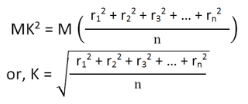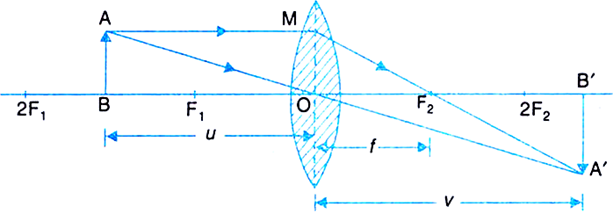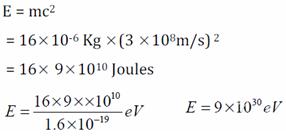Ask questions which are clear, concise and easy to understand.
Ask QuestionPosted by Mr. Singh 4 years, 11 months ago
- 4 answers
Yogita Ingle 4 years, 11 months ago
Here, R0=1.1×10−15m,A=16
R=R0A1/3
=1.1×10−15(16)1/3=1.1×10−15×2.52
=2.57×10−15m
Posted by Mr. Singh 4 years, 11 months ago
- 2 answers
Yogita Ingle 4 years, 11 months ago
Rutherford passed beams of alpha particles through a thin gold foil to observe the atom and noted how the alpha particles scattered from the foil.
Observations of Rutherford's alpha ray scattering experiment:
1.Most of the α-particles passed straight through the gold foil without any deviation.
2. Some of the α-particles were deflected by the foil by some angles.
3.Interestingly one out of every 12,000 alpha particles appeared to rebound
Conclusion of Rutherford's scattering experiment:
1.Most of the space inside the atom is empty because most of the α-particles passed through the gold foil without getting deflected.
2. Very few particles were deflected from their path, indicating that the positive charge of the atom occupies very little space.
3. A very small fraction of α-particles were deflected by very large angles, indicating that all the positive charge and mass of the gold atom were concentrated in a very small volume within the atom.

Posted by Mr. Singh 4 years, 11 months ago
- 2 answers
Posted by Mr. Singh 4 years, 11 months ago
- 3 answers
Yogita Ingle 4 years, 11 months ago
Kirchhoff’s First law: Junction law
- Junction Law is also known as Kirchhoff’s First Law.
- It states that at the junction,sum of current entering the junction is equal to the sum of current leaving the junction.
- Junction is any point in the circuit.
Kirchhoff’s Second law: Loop law
- Loop law is also known as Kirchhoff’s Second Law.
- It states that in a closed loop,algebraic sum of Emfsis equal to the algebraic sum of product of resistances and respective currents flowing through them.
- Consider a simple circuit havingEmfs = E1 and E2; R1 and R2 =resistances; current =I1 and I2.
- Then according to this law : E1+E2=I1R1+ I2R2
Muddabbir Hussain 4 years, 11 months ago
Posted by Mr. Singh 4 years, 11 months ago
- 2 answers
Yogita Ingle 4 years, 11 months ago
Lenz’s law
- According to Lenz’s law:-The polarity of the induced emf is such that it tends to produce induced current in such a direction that it opposes the change in magnetic flux that produced it.
- The (-) ive sign in given equatione= (-) (dΦ/dt)tells about the direction.
- According to Faraday’s law whenever there is change in the magnetic flux, emf is induced, as aresult there will be induced current.
- According to Lenz’s law the direction of the induced current will be such that it opposes the change in the magnetic flux.
Muddabbir Hussain 4 years, 11 months ago
Posted by Tanya ?? 4 years, 11 months ago
- 4 answers
Yogita Ingle 4 years, 11 months ago
Magnetic flux is defined as the number of magnetic field lines passing through a given closed surface. It provides the measurement of the total magnetic field that passes through a given surface area. Here, the area under consideration can be of any size and under any orientation with respect to the direction of the magnetic field.
Magnetic Flux Symbol
- Magnetic flux is commonly denoted using Greek letter Phi or Phi suffix B.
- Magnetic flux symbol: Φ or ΦB.
Mr. Singh 4 years, 11 months ago
Yashika Goyal 4 years, 11 months ago
Juhi Mishra 4 years, 11 months ago
Posted by Mr. Singh 4 years, 11 months ago
- 5 answers
Posted by Manveer Singh Gaba 4 years, 11 months ago
- 1 answers
Mr. Singh 4 years, 11 months ago
Posted by Mahesh Kumar 4 years, 11 months ago
- 1 answers
Posted by Torash Poddar 4 years, 11 months ago
- 1 answers
Yogita Ingle 4 years, 11 months ago
Optoelectronic devices are semiconductor devices in which the carriers are generated by protons via photo excitation.
A photodiode is a special type of junction diode that is used for detecting optical signals. It is a reverse biased p – n junction that is made from photosensitive material. The current in the photodiode changes with a change in the light intensity (I) when a reverse bias is applied.
Posted by Badboy Gaming 4 years, 11 months ago
- 1 answers
Tanya ?? 4 years, 11 months ago
Posted by Aryan Patel 4 years, 11 months ago
- 1 answers
Yogita Ingle 4 years, 11 months ago
Because electric field lines must be perpendicular to the surface of conductor, otherwise there would be a non zero component of electric field along the surface of conductor and charges could not be at rest.
Posted by Trending Topics 4 years, 11 months ago
- 1 answers
Posted by Rajneesh Savita 4 years, 11 months ago
- 1 answers
Dhruv Singhal 4 years, 11 months ago
Posted by Rajneesh Savita 4 years, 11 months ago
- 1 answers
Gaurav Seth 4 years, 11 months ago
De Broglie proposed that the wave length λ associated with a particle of momentum p is given by, λ = h/p = h/(m v), where m is the mass of the particle and v its speed.
The above equation is known as the de Broglie relation and the wavelength λ of the matter wave is called de Broglie wavelength.
The above equation shows that λ is smaller for a heavier particle (large m) or more energetic particle (large v).
Posted by Rajneesh Savita 4 years, 11 months ago
- 1 answers
Gaurav Seth 4 years, 11 months ago
Let  the uniform surface charge density of a thin spherical shell of radius R .Let us find out electric field intensity at a point P outside or inside the shell.
the uniform surface charge density of a thin spherical shell of radius R .Let us find out electric field intensity at a point P outside or inside the shell.
1. Field outside the shell-
Let us find out electric field intensity at a point P outside the spherical shell, such that OP=r. Here we take Gaussian surface as a sphere of radius r. the electric field intensity,  is same at every point of Gaussian surface, directed radially outwards (as is unit vector
is same at every point of Gaussian surface, directed radially outwards (as is unit vector  , so that
, so that  )
)


Hence it is clear that electric intensity at any point outside the spherical shell is such, as if the entire charge is concentrated at the centre of the shell.
2. Field at the surface of the shell-
For this we have r = R


If  is the charge density on the shell, then
is the charge density on the shell, then

3. Field inside the shell-
If the point P lies inside the spherical shell, then Gaussian surface is a surface of sphere of radius r(
As there is no charge inside the spherical shell, Gaussian surface encloses no charge.

That is q=0  E = 0
E = 0
Hence the field inside the spherical shell is always zero.
Posted by Kanishka Pant 4 years, 11 months ago
- 1 answers
Muddabbir Hussain 4 years, 11 months ago
Posted by Md Sajid515,22 4 years, 11 months ago
- 0 answers
Posted by Badboy Gaming 4 years, 11 months ago
- 3 answers
Posted by Ayush Kumar 4 years, 11 months ago
- 1 answers
Yogita Ingle 4 years, 11 months ago
A DC generator is an electrical machine whose main function is to convert mechanical energy into electricity. When conductor slashes magnetic flux, an emf will be generated based on the electromagnetic induction principle of Faraday’s Laws. This electromotive force can cause a flow of current when the conductor circuit is closed.
A DC generator can also be used as a DC motor without changing its construction. Therefore, a DC motor, otherwise a DC generator can be generally called a DC machine. Below, we have mentioned the essential parts of a DC Generator.
Posted by Rahul Thakur 4 years, 11 months ago
- 3 answers
Gumani Pokhriyal 4 years, 11 months ago
Gaurav Seth 4 years, 11 months ago
- Let a point charge(q), at any instant, is placed at distance(r) and is advancing with velocity(v) under the influence of electric field(E) and magnetic field(B). Then the net force on the charge is given by:
Fnet = FE + FB = qE + q(vxB)
Here FE = Force on charge due to electric field, FB = Force on charge due to magnetic field
This net force(Fnet) which is the vector sum of forces due to electric and magnetic fields are called as Lorentz Force, named after the scientist Lorentz, who calculated it experimentally.
Posted by Arif Khan 4 years, 11 months ago
- 2 answers
Swastika Bhattarai 4 years, 11 months ago
Posted by Mr. Singh 4 years, 11 months ago
- 1 answers
Gaurav Seth 4 years, 11 months ago
Carnot engine
- A Carnot engine is named after Carnot scientist.
- It is a reversible heat engine operating between two temperatures.
- It has a maximum efficiency which no other engine can have.
Cycle of processes in a Carnot engine
Basic Function of any heat engine is it will take heat Q1 from a hot reservoir at temperature T1 and give heat Q2 to a cold reservoir at temperature T2.
- As system is absorbing heat so it is isothermal expansion. Engine absorbs heat Q1 at temperature T1.
- An adiabatic process takes place inside the engine because of which there is increase in the temperature of the engine from T1 to T2 but no flow of heat.
- As system is releasing heat so it is isothermal contraction. Engine releases heat Q2 at temperature T2.
- An adiabatic process takes place again which changes the temperature of the system from T2 to T1.
- One cycle of Carnot engine will have Isothermal expansion then adiabatic process, and then isothermal contraction followed by adiabatic process.
- This will keep on repeating.
The efficiency of Carnot engine is given by:-
η = 1 – T2/T1
Posted by Mahima P Naik 4 years, 11 months ago
- 4 answers
Yashika Goyal 4 years, 11 months ago
Sanjana Dua?????❣️ 4 years, 11 months ago
Posted by Mahie Musharaf 4 years, 11 months ago
- 1 answers
Gaurav Seth 4 years, 11 months ago
The formula of moment inertia in terms of the radius of gyration is given as follows:
I = mk2 (1)
where I is the moment of inertia and m is the mass of the body
Accordingly, the radius of gyration is given as follows
k= √ l / m (2)
The unit of the radius of gyration is mm. By knowing the radius of gyration, one can find the moment of inertia of any complex body equation (1) without any hassle.
Consider a body having n number of particles each having a mass of m. Let the perpendicular distance from the axis of rotation be given by r1, r2, r3,…,rn. We know that the moment of inertia in terms of radius of gyration is given by the equation (1). Substituting the values in the equation, we get the <a href="https://byjus.com/jee/moment-of-inertia/">moment of inertia</a> of the body as follows

………… (3)
If all the particles have the same mass then equation (3) becomes

We can write mn as M which signifies the total mass of the body. Now the equation becomes

………… (4)
From equation (4), we get

From the above equation, we can infer that the radius of gyration can also be defined as the root-mean-square distance of various particles of the body from the axis of rotation.
Posted by Nandhini A 5 years ago
- 3 answers
Goldy Sharma 4 years, 11 months ago
Ram Naresh 4 years, 11 months ago
Posted by Naresh Singh 5 years ago
- 2 answers
Gaurav Seth 5 years ago
New cartesian sign convention for refraction of light through spherical lenses. According to this sign convention:
(i) All distances are measured from the optical centre of the lens.
(ii) The distances measured in the same direction as the incident light are taken positive.
(iii) The distances measured in the direction opposite to the direction of incident light are taken negative.
(iv) Heights measured upwards and perpendicular to the principal axis are taken positive.
(v) Heights measured downwards and perpendicular to the principal axis are taken negative.

Assumptions used in the derivation of lens formula:
(i) The lens used is thin.
(ii) The aperture of the lens is small.
(iii) The incident and refracted rays make small angles with the principal axis.
(iv) The object is a small object placed on the principal axis.
Derivation of lens formula for a convex lens. As shown in Fig, consider an object AB placed perpendicular to the principal axis of a thin convex lens between its F1 and 2F1. A real, inverted and magnified image AB' is formed beyond 2F2 on the other side of the lens.

Fig. Real image formed by a convex lens.


 ...(1)
...(1)
Also,  are similar,
are similar,


But MO = AB,

 ...(2)
...(2)
From (1) and (2), we get 
Using new Cartesian sign convention, we get
Object distance, BO = -u
Image distance, OB' = +v
Focal length, OF2 = + f


Derivation of lens formula is not included in CBSE syllabus.
or 
or 
Dividing both sides by uvf, we get

This proves the lens formula for a convex lens.

myCBSEguide
Trusted by 1 Crore+ Students

Test Generator
Create papers online. It's FREE.

CUET Mock Tests
75,000+ questions to practice only on myCBSEguide app
 myCBSEguide
myCBSEguide

Mukesh Mukesh 4 years, 11 months ago
0Thank You